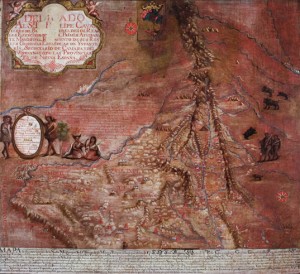 Groups of New Mexico educators found their way to the New Mexico History Museum this summer for a free, one-day workshop focused on teaching with historic maps. Led by educators Dennis and Judy Reinhartz, with assistance from Patricia Hewitt of the Fray Angélico Chávez History Library, the sessions drew from the museum’s extensive map collection. Attendees received extra insights on a number of maps through slideshow presentation, hands-on access to a few print maps, and a gallery walk-through with museum docents, who shared information on some of the maps with museum exhibits.
Groups of New Mexico educators found their way to the New Mexico History Museum this summer for a free, one-day workshop focused on teaching with historic maps. Led by educators Dennis and Judy Reinhartz, with assistance from Patricia Hewitt of the Fray Angélico Chávez History Library, the sessions drew from the museum’s extensive map collection. Attendees received extra insights on a number of maps through slideshow presentation, hands-on access to a few print maps, and a gallery walk-through with museum docents, who shared information on some of the maps with museum exhibits.
“They all have different reasons for coming here today,” Judy Reinhartz said. “Some are teachers, others are in the general field of education and some are rangers or tour guides.”
In December 2011, the Council on Library and Information Resources gave the museum a grant for “cataloging hidden collections,” specifically, the library’s 6,016 maps, which mark the evolution of mapmaking from the Spanish colonial era forward.
“Maps are developed spontaneously in different eras of history,” Dennis Reinhartz said. “They develop in response to a need within the culture of an area, and that’s what we’re teaching in these workshops.”
The trio’s work began by writing a hefty curriculum guide that contains tips and tricks on how to integrate topographic maps and cartography into lesson plans. The guide focuses on four periods of New Mexico history: the Spanish period, the Mexican period, the Territorial period, and statehood. Beyond geography, the maps help teach math, science, literature and problem-solving.
Teachers: Want to learn more? Call Hewitt at 505-476-5025.
Participants examined initial drawings of the New World, early conceptions of the region known as New Spain, and more recent depictions of the Land of Enchantment, which included travel maps and cartoon caricature maps of the Santa Fe area and New Mexico. A precious map in the discussion, Bernardo Miera y Pacheco’s Map of the Kingdom of New Mexico, shown above, is featured in The Red that Colored the World at the Museum of International Folk Art.
“What you have to do is adapt the curriculum to fit your students’ needs,” said Marilyn McClenahan, a teacher at the Sequoyah Adolescent Treatment Center’s school. “Strategies need to be beefed up for different age groups and teachers need to be able to take it back and make these tips work for their classrooms. I have the belief that everyone should be a lifelong learner. You stop learning and that’s it. You have to keep working your brain and keep exploring.”
